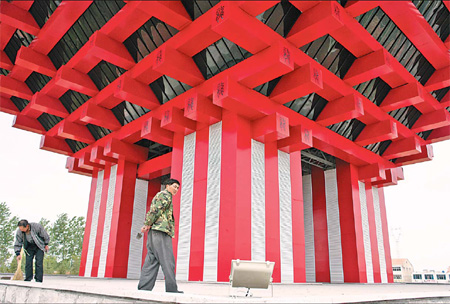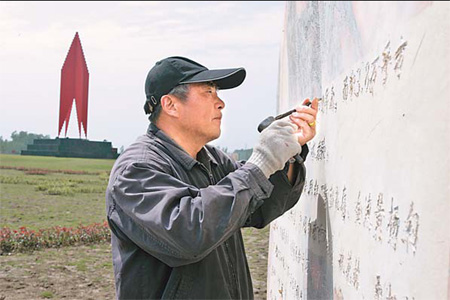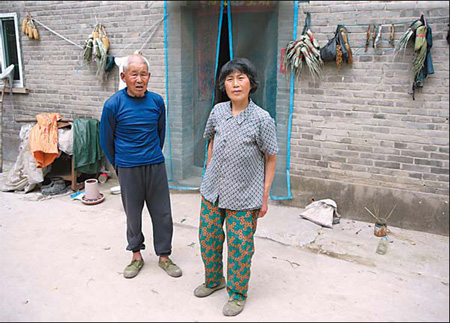'Landmarks' smear image
The mini pavilion is not Funing county's first image project. Four kilometers east of Funing town, far from most residential communities, stands another large, grass-covered square that was built on top of an old duck pond last year. In the center is a sculpture made of four reversed red flags and a stele.
County officials declined to comment when asked about the square but nearby villagers estimated the cost of the project at about 2 million yuan.
Wei Deyu, 70, who created the stele, said he began work on the project last December and earned 60 yuan for every character he carved into the granite monument, walking away with about 30,000 yuan in total.
However, although Funing is regarded as a relatively poor county in Jiangsu, it is far richer than some parts of neighboring Anhui, meaning officials can afford such projects, said Li.
Funing's GDP in 2009 was 16.6 billion yuan, up 14 percent over the previous year, while revenue rose 53 percent to 2.4 billion yuan, according to the county authority's website.
However, the county's per capita GDP last year was just 13,113 yuan, 20 percent lower than the average in Anhui and 70 percent lower than the average across the rest of Jiangsu.
In need of money
As part of a nationwide strategy launched in 1986, the central government classified 331 counties as poverty-stricken. Another 261 were added to the list in 1994.
Each one receives at least 10 million yuan in subsidies from the central and provincial governments to boost economic development, according to an official in Yuexi, one of the counties on the list in Anhui, who did not want to be identified.
Image projects in such impoverished places are not only impractical, but they can also harm an area's economic development and affect livelihoods, said Wu Weijia, director of Tsinghua University's urban planning department.
"They waste a lot of resources and restrict the long-term development of rural and urban areas," added the professor.
Chen Ru, deputy director of the Nanjing Academy of Social Sciences, agreed and said he fears the subsidies are often misused.
"Improving people's lives is much more important than building landmarks," he said, adding that local authorities need to do a lot more to help elderly people and farmers.
In Haikou, a village 35 kilometers from Funing town, Sheng Hongzuo, 67, and his 60-year-old wife, Yang Yuzhen, make 300 yuan a year by growing wheat on 2 mu (0.1 hectares) of land.
Their 15-square-meter home is considered small even for the Chinese countryside, while their kitchen consists of four walls of loose bricks that look as though they would fall down in a light breeze. They have no electrical devices and their only entertainment is two barking dogs.
Sheng is unable to use his left hand due to a disability and the couple's son has not worked since he fell from a building he was working on in Qingdao, Shandong province, two years ago.
Although the mini pavilion project was completed swiftly, Sheng said plans to construct a highway next to the village continue to be stalled - even though the village head, Wang Yacui, has already collected 300 yuan from every resident.
"I have no idea when the road will be built as my superiors have not allocated the funds," said Wang.
Funing is also one of the biggest suppliers of pigs in China, selling an estimated 400,000 a year. However, more than 3,000 piglets died in Guhe township last year due to an epidemic disease.
Farmer Zhang Shumu said he had to bury 60 pigs, costing him 8,100 yuan - more than a third of his annual income - and complained that the local authorities had offered no financial support to breeders to cover their losses.
A township official who did not want to be identified told China Daily that the authority did not have the funds to help the farmers because the county government did not allocate enough cash.
 |
| The replica China pavilion, which is a third of the size of the real one, sits in the center of an 8,000-square-meter paved area in Funing, an impoverished area in East China's Jiangsu province. |
 |
| Wei Deyu, 70, carves Chinese characters into the granite monument in a square in Funing county, Jiangsu province. He earns 60 yuan for every character he carves. |
 |
| Sheng Hongzuo and his wife, Yang Yuzhen, who make only 300 yuan a year growing wheat on 2 mu of farmland, live in Haikou, a village 35 kilometers out from the mini China pavilion. |

 0
0 







Go to Forum >>0 Comments